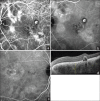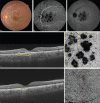Choroidal biomarkers
- PMID: 30451172
- PMCID: PMC6256910
- DOI: 10.4103/ijo.IJO_893_18
Choroidal biomarkers
Abstract
A structurally and functionally intact choroid tissue is vitally important for the retina function. Although central retinal artery is responsible to supply the inner retina, choroidal vein network is responsible for the remaining one-third of the external part. Abnormal choroidal blood flow leads to photoreceptor dysfunction and photoreceptor death in the retina, and the choroid has vital roles in the pathophysiology of many diseases such as central serous chorioretinopathy, age-related macular degeneration, pathologic myopia, Vogt-Koyanagi-Harada disease. Biomarkers of choroidal diseases can be identified in various imaging modalities that visualize the choroid. Indocyanine green angiography enables the visualization of choroid veins under the retinal pigment epithelium and choroidal blood flow. New insights into a precise structural and functional analysis of the choroid have been possible, thanks to recent progress in retinal imaging based on enhanced depth imaging (EDI) and swept-source optical coherence tomography (SS-OCT) technologies. Long-wavelength SS-OCT enables the choroid and the choroid-sclera interface to be imaged at greater depth and to quantify choroidal thickness profiles throughout a volume scan, thus exposing the morphology of intermediate and large choroidal vessels. Finally, OCT angiography allows a dye-free evaluation of the blood flow in the choriocapillaris and in the choroid. We hereby review different imaging findings of choroidal diseases that can be used as biomarkers of activity and response to the treatment.
Keywords: Choriocapillaris; choroid; enhanced depth imaging optical coherence tomography; indocyanine green angiography; optical coherence tomography angiography; swept-source optical coherence tomography.
Conflict of interest statement
There are no conflicts of interest
Figures







References
-
- Hogan MJ, Alvarado JA, Wedell JE. Histology of the Human Eye. Philadelphia: W.B. Saunders; 1971.
-
- De Stefano ME, Mugnaini E. Fine structure of the choroidal coat of the avian eye. Vascularization, supporting tissue and innervation. Anat Embryol (Berl) 1997;195:393–418. - PubMed
-
- Olver JM. Functional anatomy of the choroidal circulation: Methyl methacrylate casting of human choroid. Eye (Lond) 1990;4(Pt 2):262–72. - PubMed
-
- Spraul CW, Lang GE, Lang GK, Grossniklaus HE. Morphometric changes of the choriocapillaris and the choroidal vasculature in eyes with advanced glaucomatous changes. Vision Res. 2002;42:923–32. - PubMed
-
- Krebs W, Krebs IP. Ultrastructural evidence for lymphatic capillaries in the primate choroid. Arch Ophthalmol. 1988;106:1615–6. - PubMed

